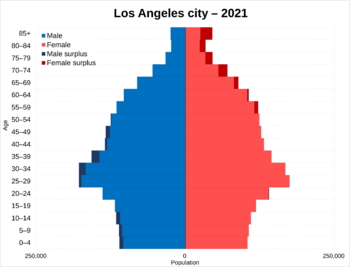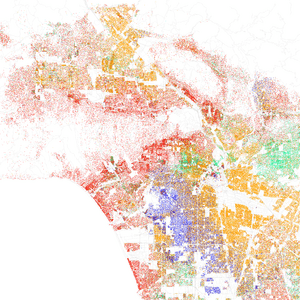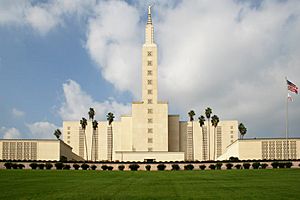Demographics of Los Angeles facts for kids
Quick facts for kids Demographics of Los Angeles |
|
|---|---|

Population pyramid of Los Angeles city in 2021
|
|
| Population | 3,979,576 (2019) |
Los Angeles is a huge and exciting city in California! To understand who lives there, we look at special surveys like the United States Census. These surveys help us learn about the people, their backgrounds, and how they live. In 2019, about 3.9 million people called Los Angeles home. That's a lot of people!
Contents
Who Lives in Los Angeles?
Different Backgrounds and Cultures
Los Angeles is known for being a very diverse city. This means people from many different places and backgrounds live there. For a long time, the number of non-Hispanic white people has been changing. By 2010, about half of the city's population was made up of Latinos. This group has grown a lot over the years.
In 2020, here's a look at the different groups living in Los Angeles:
- Hispanic or Latino (any race): 46.9%
- White (not Hispanic or Latino): 28.9%
- Asian: 11.7%
- Black or African American: 8.3%
- Two or more races: 3.3%
- Other backgrounds: 0.7%
- Native American: 0.2%
- Native Hawaiian and Other Pacific Islander: 0.1%
Most people in Los Angeles (about 59.4%) were born in the United States. However, a large number (about 39.7%) were born in other countries. Many of these people (64.5%) came from countries in Latin America. A good number (26.3%) were born in Asia. Smaller groups came from Europe, Africa, and other parts of the world.
Languages Spoken in the City
Because so many people come from different places, you'll hear many languages in Los Angeles! In 2021, over half of the people (56.8%) spoke a language other than English at home.
- About 43.2% of people spoke only English.
- Spanish is the most common language other than English, spoken by 36% of the population.
- Many Asian languages and Pacific Islander languages are also spoken (7.9%).
- Other European languages are spoken by 7.4% of residents.
- A variety of other languages make up the rest (1.4%).
Homes and Education
How People Live Together
In Los Angeles, there are many different types of households. A household is simply a group of people living together in one home.
- About 61.1% of households are "family households." This means people related by birth, marriage, or adoption live together.
- About 30.9% of these families have children under 18 years old.
- Many families (39.1%) are married couples.
- About 38.9% of households are "non-family households." This often means a person living alone or with roommates who are not family.
- About 30.2% of people in Los Angeles live alone.
Learning and Schooling
Education is important in Los Angeles. Here's a look at the schooling levels for adults over 25 years old:
- About 72.9% of adults have at least a high school diploma.
- Many people (19.2%) have a bachelor's degree from a college or university.
- About 10% have an even higher degree, like a master's or a professional degree.
- Overall, about 29.2% of adults have a bachelor's degree or higher.
Money and Well-being
Income in Los Angeles
The money people earn helps us understand the city's economy.
- The average household income in Los Angeles was about $48,610.
- For families, the average income was around $53,008.
Understanding Poverty
Sometimes, people or families don't have enough money to meet their basic needs. This is called living in poverty.
- About 15.6% of families in Los Angeles lived in poverty.
- For all people, about 18.9% were living in poverty.
- This number was higher for children under 18 years old (27.8%).
Working in Los Angeles
Jobs and the Workforce
Many people in Los Angeles are part of the "labor force," which means they are working or looking for work.
- Out of all adults aged 16 and over, about 65.8% were in the labor force.
- Most of these people (61.3%) had jobs.
- About 4.5% were looking for work but hadn't found a job yet.
More About Los Angeles's People
Religion in Los Angeles (2020 PRRI) Roman Catholicism (31%) Protestantism (35%) Mormon (1%) No religion (25%) Judaism (2%) Islam (1%) Buddhism (1%) Hinduism (1%)
Los Angeles is also home to many different religions and communities from all over the world.
- Christianity is the most common religion, with about 65% of people identifying as Christian. This includes Roman Catholicism and various Protestant churches.
- About 25% of the population does not identify with any religion.
- Other religions like Judaism, Islam, Buddhism, and Hinduism are also practiced by about 9% of the people.
Los Angeles has some unique communities:
- It has the largest group of Druze people outside of Lebanon or Syria.
- Many people from Saudi Arabia live in Los Angeles, making it the largest group of Saudi expatriates outside their home country.
- There's a large community of Louisiana Creole people, who have roots in Louisiana.
- Los Angeles is home to the largest group of Salvadoran Americans outside of El Salvador. Many came as refugees during a civil war in the 1980s and 1990s.
- The city also has the largest population of Belizeans outside of Belize.
- You can find a strong presence of Armenians in neighborhoods like Silver Lake and Hollywood.
- Los Angeles has a sizable Puerto Rican community, one of the largest west of the Mississippi River.
- The city is home to the largest population of Thai people outside of Thailand.
- More than 1.2 million Los Angeles residents have Mexican ancestry. Mexican culture has a big influence on the city.
- There are also significant communities of Italian Americans and Filipino Americans.
- Los Angeles has one of the largest populations of Roma (also known as Romani) in the U.S.
- The city is also home to a large number of Native Americans from various tribes like the Cherokee, Apache, and Navajo.
Los Angeles has been a popular place for senior citizens looking for a warmer climate for many years. It also hosts the fourth largest number of Muslims in the United States.
Where People Come From
Most immigrants in Los Angeles were born in Mexico. After Mexico, the next largest groups of immigrants come from El Salvador and Guatemala. This shows how connected Los Angeles is to its neighbors in Latin America.



